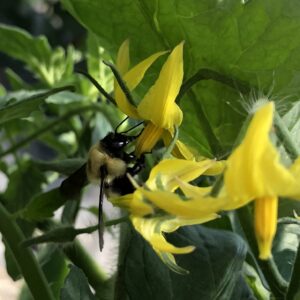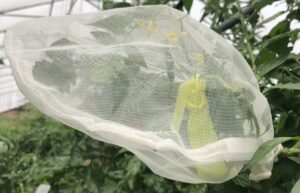The importance of bees for providing pollination is a regularly discussed topic in many fruit and vegetable production systems. Although tomatoes are often pollinated by wind, they too can benefit from bee pollination. Recent research suggests that tomato flowers visited by bees have a larger fruit set and produce heavier fruits. An ongoing study in Indiana is investigating which species of bees are important pollinators for two major tomato production systems: fresh-market high tunnel tomatoes and processing field tomatoes. This study aims to describe the pollinator communities in each system and evaluate to what extent they are providing pollination services. Preliminary results shed light on the importance of wild, native bee species for pollinating both high tunnel and field tomatoes.

Figure 1. Common Eastern bumble bee (Bombus impatiens) visiting a high tunnel tomato flower (Photo by Ella Stroh).
Buzz Pollination
Tomato flowers have poricidal anthers; their pollen is concealed within an anther cone and can be difficult for bees to access. Some bee species exhibit a behavior called “buzz pollination”, where they generate vibrations (or “buzzes”) that dislodge pollen from the anther cone and increase pollination success. Only some bees are capable of this behavior– for example, bumble bees buzz pollinate, but honey bees do not. Indiana is home to over 400 species of native bees, many of which are capable of buzz pollination. Tomatoes that are buzz pollinated have higher fruit set and weight than those that are not. Thus, the presence of buzz-pollinating species like bumble bees in tomato production can supplement or improve the pollination provided by wind.
Bees in High Tunnels
Preliminary results indicate that a variety of bees, including bumble bees and sweat bees, pollinate tomatoes in Indiana high tunnels. Bumble bees performed 61% of bee visits to tomato flowers, and 39% by sweat bees. Tomato pollinators were evaluated in high tunnels at several farms throughout the state. While bees were observed in high tunnels at some farms, they were uncommon or absent at others. It is possible that the plastic walls and hot summer temperatures in high tunnels provide potential barriers to entry for would-be tomato pollinators, and this can prevent bees from visiting high tunnels.
Pollination experiments were carried out in high tunnels to evaluate how much bees contribute to pollination and identify yield gaps caused by inadequate pollination. Some flowers were covered with mesh bags to prevent bee visits and allow for wind pollination. Other flowers were pollinated using a vibrating tomato wand to simulate a maximum pollination scenario. The fruit set and weight from each treatment were compared to a control treatment, where flowers were left open for bees to visit.
Flowers that were bagged to exclude pollinators had a significantly lower fruit set than flowers that were left open for bee visitation, suggesting that bees help to increase fruit set in high tunnel tomatoes. There was no statistical difference between fruit set or fruit weight between open flowers and supplementally pollinated flowers, suggesting inadequate pollination is not a limiting factor for high tunnel tomato yield.
Bees in Field Tomatoes
Field tomatoes are often visited by bumble bees, which comprised 93% of all observed flower visits in tomato fields across Indiana. The species most often observed was Bombus griseocollis– the Brown-belted bumble bee (pictured below). It is a widespread species in Indiana, although not the most common bumble bee species in the state overall. The apparently disproportionate number of brown-belted bumble bees in field tomatoes suggests that they are particularly important pollinators of field tomatoes. Research is ongoing to investigate whether this trend is sustained across multiple growing seasons.
Pollination experiments identical to those in high tunnels were also performed in tomato fields throughout the state. Fruit set and fruit weight were compared between pollinator-excluded flowers, manually pollinated flowers, and “open-pollinated” control flowers. Pollinator-excluded flowers had a lower fruit set than open-control flowers, and manually pollinated flowers had a higher fruit set. These results suggest that bee pollination currently contributes to fruit set in field tomatoes and that there is further potential to increase fruit set with additional pollination by bees. There was also an increase in fruit weight from the control flowers to the manually pollinated flowers. It is possible that increased pollination by bees could benefit field tomato yields by increasing average fruit weight in addition to fruit set.
Improving Tomato Pollination
There are several options available for those who want to improve pollination services to their tomatoes. One approach is to encourage bee visitation by improving the habitat for bees in and around high tunnels or fields. Bees visit tomatoes for pollen, but they must visit other flowers to access nectar. Increasing the availability of other flowering plants in areas adjacent to tomato cultivation will draw in a larger number of bees. Bees also require appropriate nesting habitats to build their nests and colonies. When providing nesting habitat, a “leave it alone” approach is often the most effective. Consider leaving some areas of land undisturbed– avoid removing leaves, frequent mowing or weeding, and heavy foot traffic. These undisturbed areas will provide nesting habitats appropriate for a variety of different bee species.
Another factor to account for when encouraging bee pollination is the frequency and timing of pesticide applications. Pesticides can have both lethal and sublethal effects on bees and often discourage them from visiting flowers. Consider timing pesticide applications around peaks in bee activity, which occur from mid-morning throughout the afternoon. Early morning or evening applications can minimize the impact pesticides have on bees. When possible, reducing the overall frequency of pesticide applications is also beneficial for encouraging bee pollination.
Want to help with tomato pollinator research?
The tomato pollination study is ongoing, and we are currently recruiting tomato growers to participate in the 2023 growing season. If you are a producer of high tunnel or field tomatoes located in Indiana and would like to hear more about participating in the project, please reach out to Ella Stroh in the Purdue Entomology department: stroh2@purdue.edu.
References
Franceschinelli, E. V., Neto, C. M. S., Lima, F. G., Gonçalves, B. B., Bergamini, L. L., Bergamini, B. A. R., & Elias, M. A. (2013). Native bees pollinate tomato flowers and increase fruit production. Journal of Pollination Ecology, 11, 41–45. https://doi.org/10.26786/1920-7603(2013)4
Vallejo-Marín, M. (2022). How and why do bees buzz? Implications for buzz pollination. Journal of Experimental Botany, 73(4), 1080–1092. https://doi.org/10.1093/jxb/erab428
Winfree, R., Williams, N. M., Gaines, H., Ascher, J. S., & Kremen, C. (2008). Wild bee pollinators provide the majority of crop visitation across land-use gradients in New Jersey and Pennsylvania, USA. Journal of Applied Ecology, 45(3), 793–802. https://doi.org/10.1111/j.1365-2664.2007.01418.x
